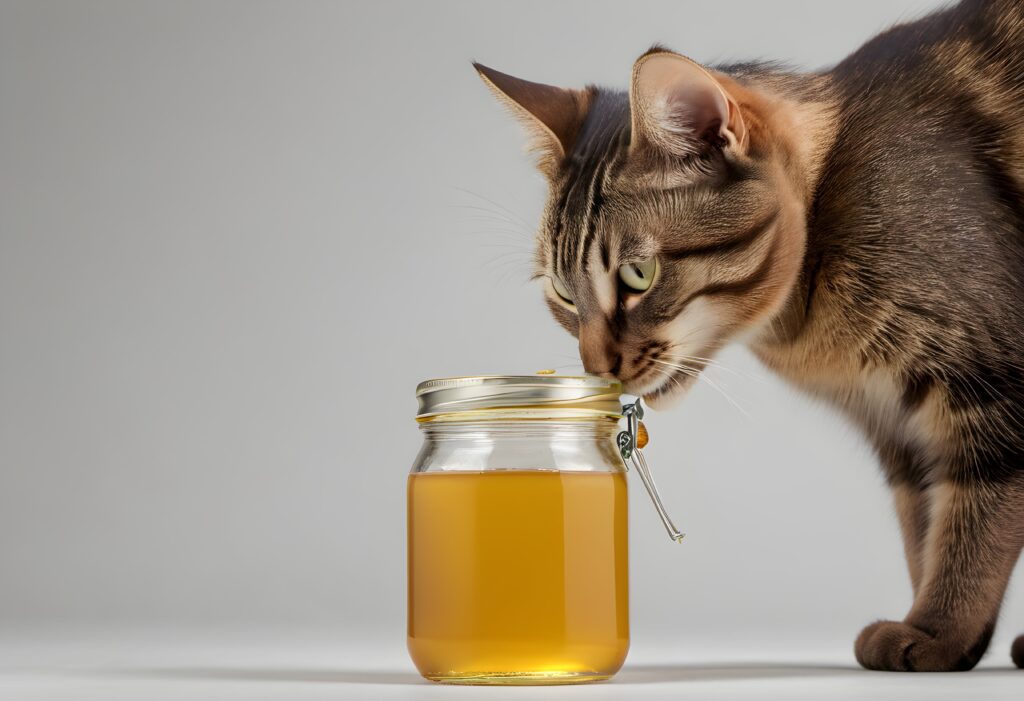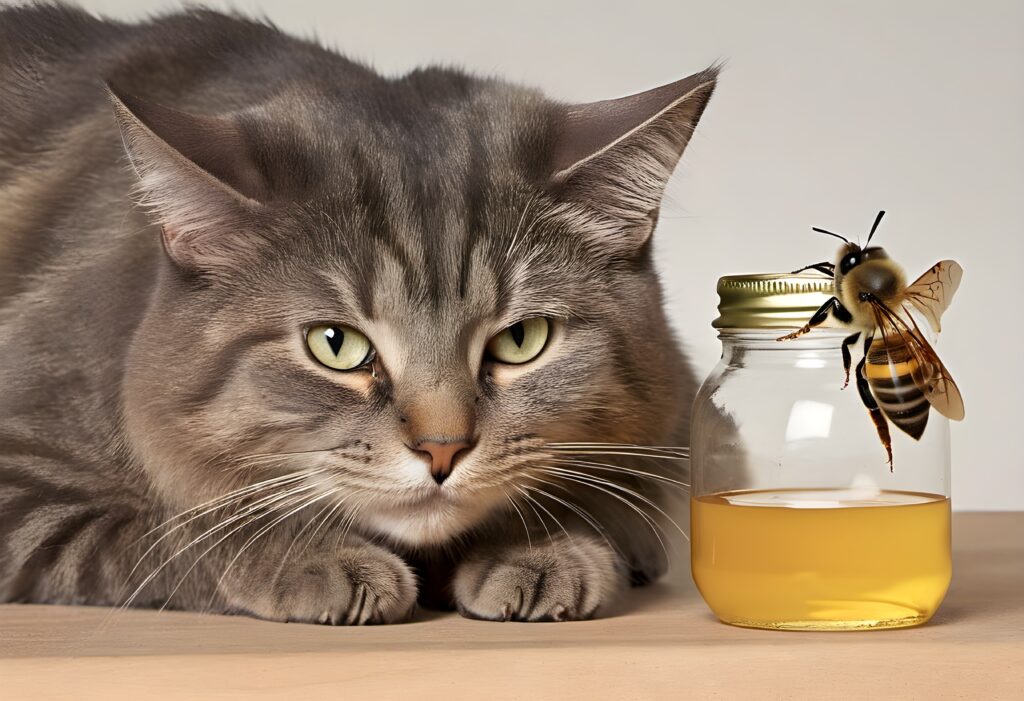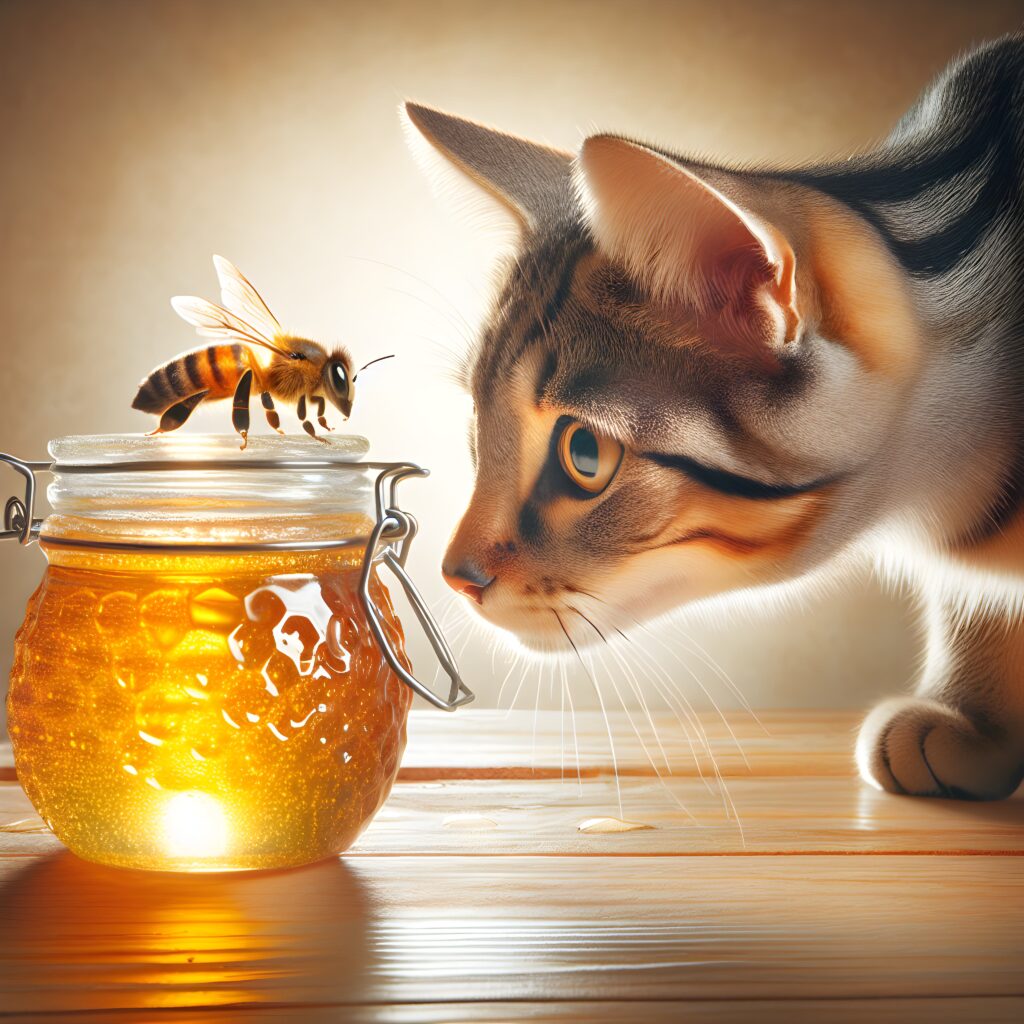If you own a cat or cats, chances are that you are giving them the same thing to eat every day – the same canned food, the same dry kibble, the same cat treats. Many cat owners want to spice up their pets’ diets from time to time by giving them “people” food, including sweets such as honey.
But can cats eat honey? This question isn’t just about if cats can eat honey but also if they actually should and whether it’s good for them, given their meat-eating habits and dietary requirements.

Can Cats Eat Honey: Cats as Obligate Carnivores & What This Means For Their Diet
Cats are classified as obligate carnivores, which means their bodies are designed to thrive on a diet primarily composed of meat.
In contrast to omnivores or herbivores, obligate carnivores require animal protein to obtain certain essential nutrients that their bodies cannot synthesize from plant-based sources. These nutrients include taurine, arachidonic acid, and vitamin A, all essential nutrients that cats can only get through a meat-based diet.
This means that carbohydrates, including honey, are of limited benefit to cats primarily because their bodies have evolved to metabolize proteins and fats more efficiently, which fits with their natural diet of small animals.
Since the cat’s energy needs are best met through proteins and fats, excess carbohydrates are not useful to them and can even be harmful to their health. Their digestive systems lack certain enzymes that are essential for breaking down carbohydrates effectively.
As a result, too many carbs in their diets can lead to unused sugars in the cat’s body, potentially causing short-term health issues such diarrhea and long-term problems like obesity and diabetes.
Cats and Their Sense of Taste
Cats have a different set of taste receptors compared to humans. While humans can taste sweet, sour, salty, bitter, and umami flavors (1), cats have a reduced ability to taste sweetness.
This difference arises because cats lack a functional form of the gene that codes for the sweet taste receptor. This gene, known as Tas1r2, is required for detecting sugar and carbohydrate-based sweeteners in humans and many other animals.
Scientific studies support this understanding. Studies by Li et al. (2005, 2006) found that the mutation in the Tas1r2 gene in cats leads to their inability to taste sweet flavors (2,3).
This mutation is not just observed in domestic cats but also in other felid species, suggesting an evolutionary trait across the cat family. “”This molecular change was very likely an important event in the evolution of the cat’s carnivorous behavior”, suggests the author.
Since cats do not perceive sweetness, they do not seek out sweet foods with the same interest as humans or other animals might. This aligns with their dietary needs as obligate carnivores.
The absence of sweet taste receptors suggests that adding sweet flavors to a cat’s diet is unnecessary and would likely be unappealing to them. It also emphasizes the importance of focusing on cat-appropriate foods that cater to their specific nutritional needs rather than imposing our human-like preferences on them.

The Risks of Honey for Cats
Even if your cat wants to eat honey, she probably shouldn’t. Honey is not ideal for a cat’s diet primarily due to its high sugar content. Cats derive their energy mainly from proteins and fats, and foods that are high in sugar can cause stomach upsets and digestive problems.
If fed repeatedly, the excessive sugar in honey can also lead to other health issues for cats such as obesity and diabetes. These conditions occur when cats consume more energy than they can use, leading to fat storage and potential disruptions in insulin regulation.
Furthermore, while honey itself is not typically associated with allergies in cats, it can contain pollen, which might trigger reactions in cats with known pollen allergies. The indirect exposure to allergens through honey could potentially cause symptoms in sensitive individuals.
Given these factors, it’s best to err on the side of caution and avoid feeding honey to cats. It is easier to maintain their health and avoid unnecessary risks associated with its high sugar content and potential allergen presence than it is to try and fix health problems after they occur.
Botulism Risk in Kittens and Young Cats
Botulism is a rare but serious illness caused by a toxin that affects the nervous system and can lead to paralysis (4). The toxin is produced by the bacterium Clostridium botulinum, which is commonly found in soil and dust.
In honey, these bacteria can survive because of honey’s low water activity and high sugar content. When ingested, the spores can germinate, allowing the bacteria to grow and produce toxins in the gastrointestinal tract.
In human infants, the risk of botulism from honey is well-documented (5). Infants have immature digestive systems and cannot prevent the growth of harmful organisms like Clostridium botulinum. This makes them particularly vulnerable to botulism, which is why health authorities recommend avoiding giving honey to children under one year of age.
Similarly, kittens are at risk because their digestive systems are also not fully developed. Their less acidic stomachs and immature immune systems may not effectively inhibit the growth of Clostridium botulinum spores.
Although specific studies on kittens and botulism are limited, the parallels to human infants highlight the potential dangers.
Thus, eating honey or any other food that could contain these spores poses a significant health risk to kittens. Due to these risks, it is best to avoid feeding honey to kittens and young cats to prevent the possibility of botulism.

Honey as an Ingredient in Other Foods
Honey is a common sweetening ingredient in various foods, especially sweets and baked goods such as bread, muffins, cereals, and some processed snacks.
Botulism spores are not destroyed by cooking, and foods made with honey may contain viable spores. These items, while appealing to humans, are not suitable for cats for the same reasons honey itself is not.
Additionally, many of these foods may also contain other ingredients that may be harmful to cats, such as chocolate, raisins, or artificial sweeteners like xylitol. Always read food labels carefully before letting your cat have a taste of “people food”.
What To Do If Your Cat Eats Honey
If your cat eats honey, it’s generally not a cause for immediate concern, as honey is not toxic to cats. The most common issue that might occur is a mild stomach upset, which could include symptoms like diarrhea or vomiting due to the high sugar content in honey.
However, if your cat shows any signs of distress such as persistent vomiting, diarrhea, or appears unusually lethargic, you should contact your veterinarian. It’s better to be cautious and have your cat checked to ensure that there are no serious complications resulting from the ingestion of honey.

[Image credits: All images are used under license or with permission]
Related articles:
- Can Cats Eat Eggs: Cracking the Code on Feline Nutrition
- Do Cats Eat Turtles? What You Need To Know
- Are Blue Tailed Lizards Poisonous To Cats?
- Can Cats Eat Strawberries (and other strange stuff)
References:
- Lindemann, Bernd. “Taste reception.” Physiological reviews 76.3 (1996): 719-766.
- Li X, Li W, Wang H, Cao J, Maehashi K, et al. (2005) Pseudogenization of a Sweet-Receptor Gene Accounts for Cats’ Indifference toward Sugar. PLOS Genetics 1(1): e3. https://doi.org/10.1371/journal.pgen.0010003
- Li X, Li W, Wang H, Bayley DL, Cao J, Reed DR, Bachmanov AA, Huang L, Legrand-Defretin V, Beauchamp GK, Brand JG. Cats lack a sweet taste receptor. J Nutr. 2006 Jul;136(7 Suppl):1932S-1934S. doi: 10.1093/jn/136.7.1932S. PMID: 16772462; PMCID: PMC2063449.
- CDC: About Botulism
- https://www.orpha.net/pdfs/data/patho/Pro/en/InfantBotulism.pdf

